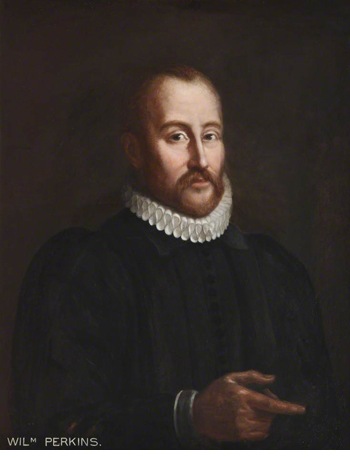
William Perkins
(Artist unknown, 1602)
A CONTINUING ANXIETY
The great division between the elect and the non-elect is of course independent of class divisions and - despite the 'perpetual study and practise of mortifying the flesh' - of ascetic effort. Kuyper complains of 'Rome' that:
'She knew religion only as it existed in her own Church, and considered the influence of religion to be confined to that portion of life which she had consecrated. I fully acknowledge that she tried to draw all human life as far as possible into the holy sphere, but everything outside this sphere, everything not touched by baptism, nor aspersed by her holy water, was devoid of all genuine religious efficiency. And just as Rome drew a boundary line between the consecrated and the profane sides of life, she also subdivided her own sacred precincts according to different degrees of religious intensity - the clergy and the cloister constituting the Holy of Holies, the pious laity forming the Holy Place, thus leaving the Outer Court to those who, although baptised, continued to prefer to church-devotion the often sinful pleasures of the world - a system of limitation and division, which for those in the Outer Court, ended in setting nine tenths of practical life outside of all religion. So religion was made partial, by carrying it from ordinary days to days of festival, from days of prosperity to times of danger and sickness, and from the fulness of life to the time of approaching death. A dualistic system which has found its most emphatic expression in the praxis of the Carnival, giving Religion a full sway over the soul during the weeks of Lent, but leaving to the flesh a fair chance, before descending into this vale of gloom, to empty to the dregs the full cup of pleasure, if not of mirth and folly.'
The Calvinist church was a church for ordinary people with no opportunity to be extraordinary other than that provided by the role of the preacher - no monks, nuns, fools for Christ, bishops, deacons with beautiful voices. This church was open to everyone (in Calvin's original idea, obligatory for everyone) and everyone could participate fully on the assumption that they were as 'good' - as certain of salvation - as anyone else, provided their lives weren't scandalous or they weren't giving voice to heretical thoughts. That I think describes quite well the Scottish tradition and the extension of the Scottish tradition I studied in the North of Ireland.
But not necessarily the Anglo Saxon tradition, both as expressed in the puritanism that came to the fore in the Civil War, and its extension in North America. There, it seems, the old anxiety, lack of an assurance of salvation, still waxed strong, and it was in this context that the need was felt for a conversion experience, a particular moment of transition when the believer would know with certainty that he or she had passed from a certainty of eternal damnation to a certainty of salvation. As expressed in the popular hymn, Amazing Grace. Furthermore an idea emerged which seems to me to be quite antithetical to Calvin's own doctrine, that the quality of the conversion experience could be judged by a set of clearly defined psychological criteria.
A pioneer in this field was the early seventeenth century English reformer, William Perkins. He outlined ten stages of the subjective experience of conversion. The first three - attendance on the word, knowledge of the law and awareness of sin - effectively an intellectual knowledge of what was necessary - did not indicate any operation of saving grace. The work of saving grace begins with the fourth stage - 'legal fear', a real conviction that one is sunk in sin and therefore liable to eternal damnation. The path to salvation necessarily passes through doubt and despair. To quote Perkins: 'To see and feel in ourselves the want of any grace pertaining to salvation and to be grieved therefore is the grace itself.' This is followed by consideration of the promise of salvation, a will to believe, a struggle with doubt, a persuasion of mercy (this is the beginning of assurance of salvation), evangelical sorrow (perhaps resembling the 'joyful sorrow' that is a quality celebrated in the Orthodox Church) and finally a 'new obedience' - a fulfilled transformation of character. A feeling of religious security without having gone through such a process was seen by Perkins as the sure sign of a damned soul.(16)
(16) Account of Perkins from Edmund Morgan: Visible Saints: The history of a Puritan idea, New York University Press, 1963, pp.68-70.
This is broadly the pattern that will be familiar to anyone who has read John Bunyan's Grace Abounding and I would suggest that although the foundation is laid in the teaching of John Calvin, it is very much an Anglo-Saxon development.
It was in America that for the first time an experience of this kind became a necessary condition of full membership of the church and we see emerging the category of 'visible saints'. But although candidates for membership of the church had to persuade existing church members that they had indeed undergone such an experience, the experience itself was still a lonely process. It is in the eighteenth century that we see the next stage in the long trajectory from Calvin to Sister Rosetta. And this is where Wales comes into the picture. We are now talking about the phenomenon of Revival.